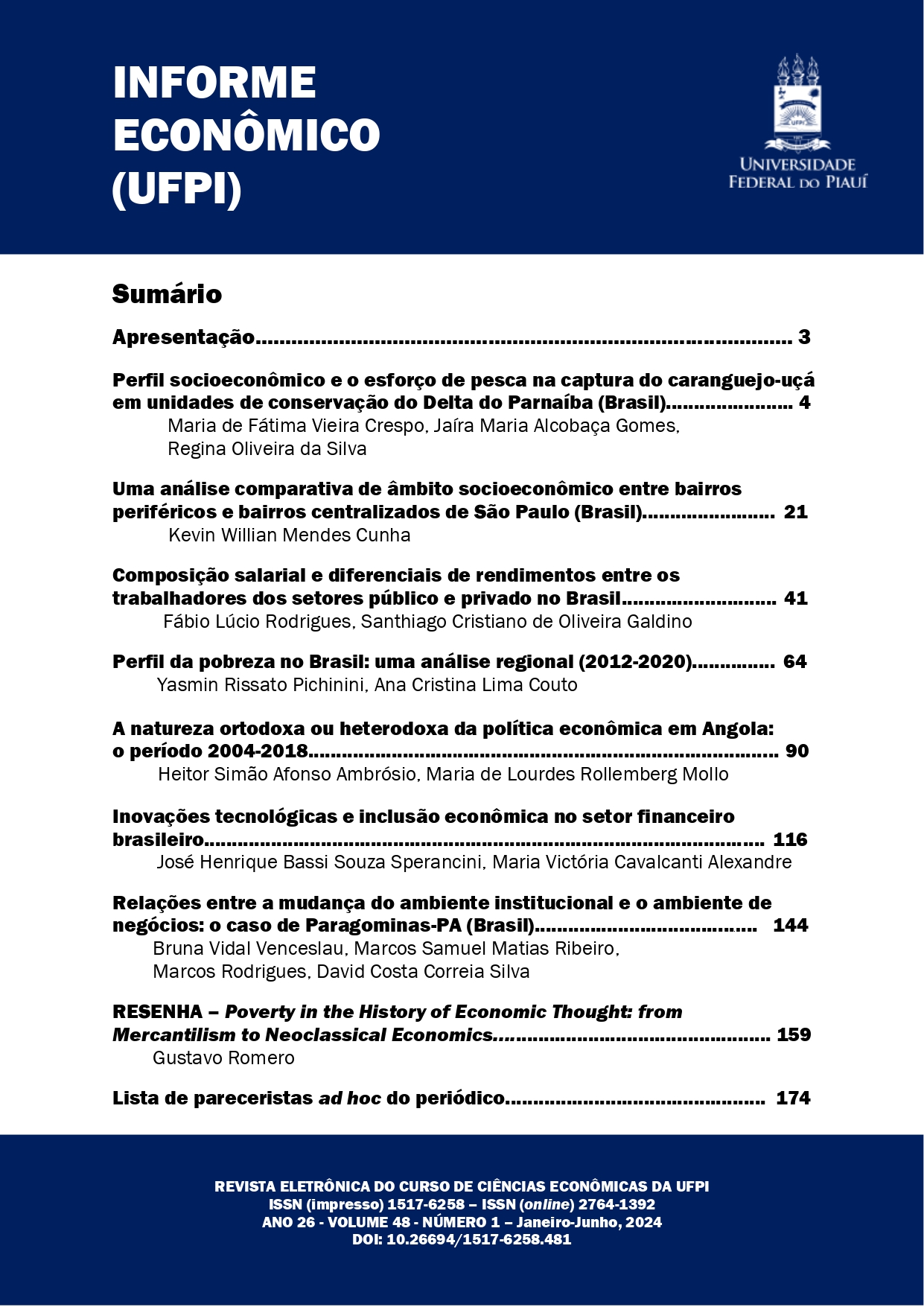a comparative analysis of the socio-economic environment between the peripheral and centralized districts of são paulo
DOI:
https://doi.org/10.26694/2764-1392.5617Keywords:
São Paulo. Economia. Desenvolvimento Urbano. Bem-estar social. Mobilidade.Abstract
The aim of this article is to deepen critical thinking in relation to the contrast in social and economic conditions, based on an approach to socio-spatial development in the city of São Paulo and its districts and administrative units (subprefectures).
In short, the contexts and historical facts will be addressed in conjunction with graphs, economic and social data, so that they will be used in this article as a tool for gathering information, in order to draw new perspectives on the hegemony of average income in regions far from the center of the capital, in order to absorb the effects of the important performance of a neighborhood, especially a peripheral one, in a major capital in the country.
As a result, the article will be the basis for the development of research that tends to illustrate the interdisciplinarity of economic sciences with information and research in the social sciences, such as law. In general, facts need to be addressed in order to understand how societies can (or cannot) advance due to their local economy.
References
ARAÚJO, M. R. M. de. et al. Transporte público coletivo: discutindo acessibilidade, mobilidade e qualidade de vida. Psicologia & Sociedade, v. 23, p. 574-582, 2011.
ATLAS BRASIL. Atlas do Desenvolvimento Humano no Brasil. Consulta em tabela 2022. Disponivel em: http://www.atlasbrasil.org.br/consulta/planilha. Acesso em: 15 fev. 2024.
BALTAZAR, C. G. A habitação de interesse social e o direito à cidade: entre os distritos de Cidade Tiradentes e Grajaú. Tese (Doutorado em Serviço Social) - Programa de Estudos
Pós-Graduados em Serviço Social da Pontifícia Universidade Católica de São Paulo, São Paulo, 2021.
CARDOSO, C. E. de P. Análise do transporte coletivo urbano sob a ótica dos riscos e carências sociais. 2008. 138 f. Tese (Doutorado em Serviço Social) - Pontifícia Universidade Católica de São Paulo, São Paulo, 2008.
DIAS, C. R.; SAKR, F. L. Centralidade urbana: configuração espacial e condições socioeconômicas na cidade de São Paulo, Brasil. In: SEMINÁRIO INTERNACIONAL DE INVESTIGACIÓN EN URBANISMO, BARCELONA-BOGOTÁ, 6.; junio 2014, Barcelona.
Conferece report […]. Barcelona: Universitat Politècnica de Catalunya, 2014.
HIGA, C. V. Políticas de transporte coletivo em São Paulo entre 2001 e 2010: meio ambiente construído, sistemas técnicos e organização dos serviços de transporte. 2012. Dissertação (Mestrado em Geografia Humana) – Universidade de São Paulo. 2012.
JACOBI, P. Do centro à periferia: meio ambiente e cotidiano na cidade de São Paulo. Ambiente & Sociedade, p. 145-162, jun. 2000.
PREFEITURA DE SÃO PAULO. Índice de mobilidade por tipo de viagem. Pesquisa Origem e Destino. Disponível em:
https://www.prefeitura.sp.gov.br/cidade/secretarias/upload/chamadas/indice_de_mobilidade_por_ti po_de_viagem_2017_1663947161.htm. Acesso em: 15 de fev. 2023.
PREFEITURA DE SÃO PAULO. Mapa da Cidade. Secretaria Municipal de Desenvolvimento Urbano. 2024. Disponível em: https://www.prefeitura.sp.gov.br/cidade/secretarias/subprefeituras/subprefeituras/mapa/index.php? p=250449. Acesso em: 4 de mar. 2024.
VASCONCELLOS, E. A. Transporte urbano, espaço e eqüidade: análise das políticas públicas. São Paulo: Annablume, 2001.
VILLAÇA, F. As ilusões do plano diretor. São Paulo, Edição do autor, 2005.
VILLAÇA, F. São Paulo: segregação urbana e desigualdade. Estudos avançados, v. 25, p. 37-58, 2011.
Downloads
Published
Issue
Section
License
Copyright (c) 2024 INFORME ECONÔMICO (UFPI)

This work is licensed under a Creative Commons Attribution 4.0 International License.





